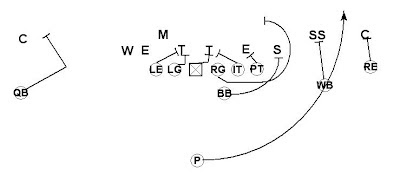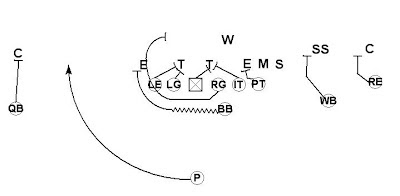Using the Punt as a Weapon
Many coaches look at punting as the raising of the white flag when on offense. Some coaches even look at punting as what you do when you've failed to move the ball. I look at punting as an opportunity to stress my opponent even further. For years I was like the others and simply aligned in a standard tight punt formation, punted the ball, hoped like hell my guys covered well and got the defense on the field. Well, not anymore! I'm going to take you through some of the evolution of my punt teams to where we are today and show you how you should relish the chance to punt the football instead of looking at fourth down as a failure!
Loco Punt
A few years back in American Football Monthly magazine, there was an article on the Loco Punt. I can't remember the specifics, but I remember the scheme being very simple, fake friendly and utilized directional punting. What I really liked about the Loco Punt was not only the directional punting, but the fact you punted towards a split receiver, who could release and get down field quickly. I also liked all the fake potential the Loco Punt had as well. Here is the base formation:
The punter started by initiating a "shift" call which took the WB and moved him on the LOS and dropped the RE off. Once set, the RE would then go in motion and align as a wing to the left side of the formation as shown below.
The motion would really get the defense to working now, as they had to honor the change of strength, which is something not many defenses deal with well, when facing a punt team. The more and more we ran this, the more punt safe defenses we saw. The final formation is shown below.
From here, if the defense did not adjust we could either punt the football or run a sweep fake to the side the defense did not adjust to . If the defense over adjusted, then we could run a sweep fake to the side they left open. There was also a pass fake to go along with it as well. All of these fakes, coupled with the shift and motion, made life miserable on the return team. This was my goal all along.
The punt protection and coverage schemes were also very simple, so much so we really only repped them once a week. The fakes made us known around our league as a team that fourth down didn't always mean we were going to punt. The last season I was in charge of the punt team we had a punt fake success rate of over 75 percent with 7 or less yards to gain (it helped our punter was also an option QB)!!! Needless to say I was sold on the idea that punting was "giving up".
The Wildcat Punt
Well, enter my new job, where last year I really only dealt with defense, and now this season due to our head coach being sick, I'm now in charge of just about EVERYTHING! So, I got a chance to go back to the punt team. Well, we have chosen to run Dave Cisar's Unbalanced Single Wing Offense and one formation in his playbook is very similar to the good ol' Wildcat. I looked at that formation some time before deciding to go with some things, but here's what I came up with and so far we've been DEADLY with our punt team.
All of the above is our normal alignment for our Wildcat package with the exception of the depth of the punter. I have chosen to shift into this look from our base look so our Punter aligns at three-and-a-half yards back, and then shifts back to his normal ten yard depth (this is junior high football, if it were high school I'd be back at 12-13 yards). From the get-go you can see the defense is forced to honor the three receivers by covering them man-to-man, or else risk the quick throw for the first down. Being unbalanced we have our BB look for any overloads by the defense before signaling all clear and ready to punt. Ideally, we are going to punt the ball if we get four defenders strong and three defenders weak (as shown above). When we punt, the blocking is simple, as we have adopted Cisar's GOD (Inside Gap, On, Down) blocking scheme for our punts as well. So all the players on the LOS block using this GOD rule, and they do so for a two count. The BB releases outside and walls off any defenders coming outside the PT. So the blocking for the above front would be as follows:
Now I know what you are thinking, wait, the DE on the punt team's left side has a free run to the punter. Well, we rugby punt, so on the snap we are putting distance between the DE and the punter immediately. The other little addition we had to add was that the LOS players treat the LB's as though they were in their inside gap (since most of Cisar's stuff does not involve OL blocking LB's, we had to improvise a bit). The blocking back simply takes the outside rusher wherever he wants to go and the punter either goes around the block and punts, or steps up inside and punts. Either way the edge rusher cannot be right.
Coverage is also very easy, and since most teams can ill afford to give up six players to double team the three gunners you have presented them, you now have easy free releases down field for the RE, LE and the WB. The coverage for the Wildcat punt is shown below:
The RE will release outside and works to the outside hip of the returner. The WB has a 2 way go, but must end up in the middle of the returner (he does not pick a side). The QB will work to the inside hip of the returner, and must get an inside release (we've had him fake outside then come underneath vs. press looks). The BB will secure his block and then will work to the punt-side hash mark and is a 1/2 field safety. The punter punts the ball, and will signal if it's a bad punt and then will drift back to the opposite hash mark and play the 1/2 field safety away from where the ball was punted. All other players, after securing their blocking assignment, will take a natural pursuit path to the football. Having the three gunners has allowed us to remove some of the traditional "lanes" many of us were schooled on (and some of struggled at teaching) because we are essentially having the hounds flush the prey to the hunters. Lanes don't really matter all that much, although we do work them, however the idea here is get your block, then fly down field to the ball.
The fakes are the key essentials to the Wildcat punt as well. If we want our punter to read the punt return team's reaction to our scheme, we give him a "green" call, which stands for green light if the punt return team bails out in coverage. The punter will see this and simply tuck the ball and run for the first down.
We will also look for overloads by the defense and call our fakes accordingly. We have three of these, two runs and one pass. The first fake is simply our sweep to the right, shown below.
The OL simply blocks the GOD rule (inside gap, on, down) with the right guard pulling and wrapping while the BB leads. This call has been made because the defense decided to give us four players to our two-man surface. Depending on who you have at punter either the punter can call this fake or the coach, but either way you have caught the defense guessing, and now are making them pay for it.
If the defense chooses to overload the strong side of the formation, we simply check to the sweep to the weak side. Since we rugby punt, many teams will try to do this overload, but it leaves them extremely weak to the short side of the formation.
The BB will shift over to the weak side and we will snap the ball once he is set. Again the right guard pulls and the BB leads the play.
If the distance to go is greater than you want to run for it, or the defense has remained balance, yet you still need the fake, the pass fake is a good way of moving the ball down field. The RE will clear the zone by releasing outside as if covering and running a "go" route. The WB, will also take his normal release, but will run an out route instead of covering (this route is usually wide open because the safety has been trying to block the WB all night long covering punts, he does not expect an out route here). The QB, will drag across the formation looking to come out on the strong side about two yards deep giving the punter an outlet receiver if he gets in trouble. The line blocks with hinge protection and the BB slides out and blocks the first threat outside the PT. The punter gets the snap looks to punt for two steps then rolls out looking to hit the WB at the first down marker.
So far teams have quit trying to line up and get a return on us and are staying back and playing defense. This gives our punt team a huge advantage because the rush is slowed, and there is nobody to worry about returning the football. So far we are averaging a little over 35 yards a punt and have given up zero punt return yards!
Duece










0 Response to "Using the Punt as a Weapon"
Post a Comment